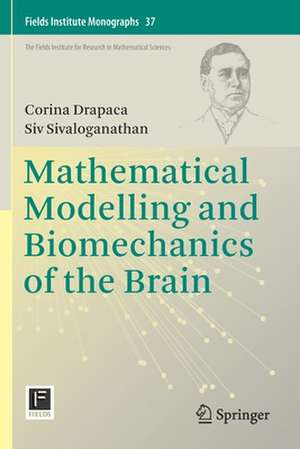Mathematical Modelling and Biomechanics of the Brain: Fields Institute Monographs, cartea 37
Autor Corina Drapaca, Siv Sivaloganathanen Limba Engleză Paperback – 7 sep 2019
With the beginning research student in mind, the chapters have been crafted to be as self-contained as possible while addressing different clinical conditions and diseases. The book is intended as a brief introduction to both theoreticians and experimentalists interested in brain mechanics, with directions and guidance for further reading, for those who wish to pursue particular topics in greater depth. It can also be used as a complementary textbook in a graduate level course for neuroscientists and neuroengineers.
| Toate formatele și edițiile | Preț | Express |
|---|---|---|
| Paperback (1) | 448.17 lei 6-8 săpt. | |
| Springer – 7 sep 2019 | 448.17 lei 6-8 săpt. | |
| Hardback (1) | 641.71 lei 6-8 săpt. | |
| Springer – 7 sep 2019 | 641.71 lei 6-8 săpt. |
Preț: 448.17 lei
Nou
Puncte Express: 672
Preț estimativ în valută:
85.77€ • 93.13$ • 72.04£
85.77€ • 93.13$ • 72.04£
Carte tipărită la comandă
Livrare economică 22 aprilie-06 mai
Preluare comenzi: 021 569.72.76
Specificații
ISBN-13: 9781493998128
ISBN-10: 1493998129
Pagini: 155
Ilustrații: X, 155 p. 12 illus.
Dimensiuni: 155 x 235 mm
Greutate: 0.27 kg
Ediția:1st ed. 2019
Editura: Springer
Colecția Springer
Seria Fields Institute Monographs
Locul publicării:New York, NY, United States
ISBN-10: 1493998129
Pagini: 155
Ilustrații: X, 155 p. 12 illus.
Dimensiuni: 155 x 235 mm
Greutate: 0.27 kg
Ediția:1st ed. 2019
Editura: Springer
Colecția Springer
Seria Fields Institute Monographs
Locul publicării:New York, NY, United States
Cuprins
1. Introduction.- 2. Brief Review of Continuum Mechanics Theories.- 3. Mechanics of Hydrocephalus.- 4. Modeling Traumatic Brain Injuries, Aneurysms, and Strokes.- 5. Models of Tumor Growth.- 6. Concluding Remarks.
Textul de pe ultima copertă
This monograph aims to provide a rigorous yet accessible presentation of some fundamental concepts used in modeling brain mechanics and give a glimpse of the insights and advances that have arisen as a result of the nascent interaction of the mathematical and neurosurgical sciences. It begins with some historical perspective and a brief synopsis of the biomedical/biological manifestations of the clinical conditions/diseases considered. Each chapter proceeds with a discussion of the various mathematical models of the problems considered, starting with the simplest models and proceeding to more complex models where necessary. A detailed list of relevant references is provided at the end of each chapter.
With the beginning research student in mind, the chapters have been crafted to be as self-contained as possible while addressing different clinical conditions and diseases. The book is intended as a brief introduction to both theoreticians and experimentalists interested in brain mechanics, with directions and guidance for further reading, for those who wish to pursue particular topics in greater depth. It can also be used as a complementary textbook in a graduate level course for neuroscientists and neuroengineers.
With the beginning research student in mind, the chapters have been crafted to be as self-contained as possible while addressing different clinical conditions and diseases. The book is intended as a brief introduction to both theoreticians and experimentalists interested in brain mechanics, with directions and guidance for further reading, for those who wish to pursue particular topics in greater depth. It can also be used as a complementary textbook in a graduate level course for neuroscientists and neuroengineers.
Caracteristici
Features the current state of the art, with elementary models and current research at the frontiers of the field contained in each chapter Reviews both common and deadly clinical conditions encountered by neurosurgeons Expresses a unified approach to modelling brain conditions through the use of biomechanics and its extensions, giving readers a high-level perspective of clinical conditions of the brain












